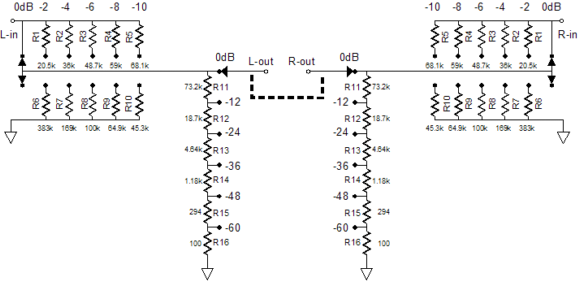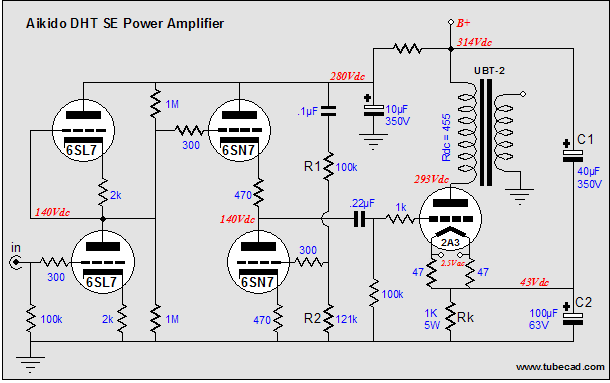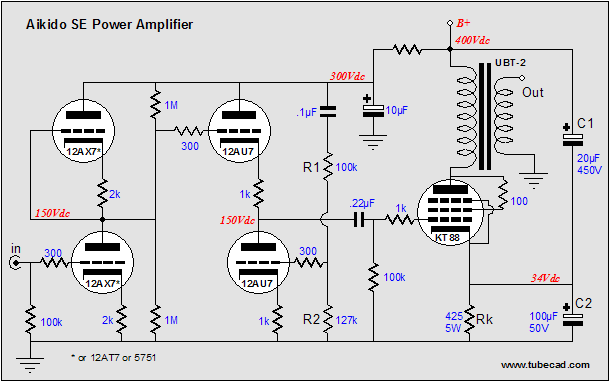| John Broskie's Guide to Tube Circuit Analysis & Design |
26 March 2006 Aikido PCB update
Three-Switch Stepped Attenuators 
In other words, the attenuator holds its own balance control of sorts. The center knob controls the volume for both channels, and offers six large -12dB decrements; the flanking knobs offer six fine -2dB decrements for each channel, creating a volume control and balance control in one easy-to-use stepped attenuator. Why did I also offer this attenuator for sale with the Aikido boards? The Aikido amplifier is so good I was loathe to imagine the cheap, bad-sounding volume potentiometers that would be used with it and I knew that few would want to buy an expensive stepped attenuator. So, this attenuator ($49 complete with resistors or $39 without) was an ideal way to help build a great line amplifier for a lot less money. 
By the way, speaking of lots less money, my friends tell me that I am charging too little for the boards. In fact, customers, who have the boards in hand, tell me that I am charging too little for the boards. While I know that some believe that the more a piece of audio gear costs, the better it must sound, I am tickled by the idea of being able to build an entire line stage for less than $300 that will make your friends who own the high-priced spread green with envy.
Low-Voltage Aikido The 12SX7 is a 6SN7-type tube with a difference: it can work at a much lower cathode-to plate voltage, say 40 volts. Still I would prefer to use a B+ voltage of 250 to 300 volts with this tube, as, in general, every extra volt and every extra milliamp of current makes for a better sound. However, there might be a situation where a lower B+ is desirable. In an Aikido headphone amplifier (300-ohm load) that used a 6BX7 as the output tube, the 12SX7 would make a great choice for the input tube, when the B+ voltage was only 140 volts, for example. (The 6BX7 can draw an idle current of 30mA with only 70 volts on its plate, which is more than enough to drive Sennhieser 300-ohm headphones to deafening levels.)
Aikido Power Amplifiers
This amplifier is double Aikido-ized, in that the SE output stage uses a PS noise canceling technique that was laid out long ago in the Tube CAD Journal. Capacitors C1 and C2 inject a portion of the PS noise into the cathode of the output tube, which, in turn, cancels the noise across the transformer's primary. Here is the same idea with a KT88/6550 output tube.
I also know a few will use an Aikido PCB to make hybrid amplifiers, both single-ended and push-pull. The secret is to couple a unity-gain power buffer stage to the Aikido’s output. More details next time; I promise Next time
*A while ago, in Northern California, I ran into an Aikido expert, someone who not only understood circuit in its entirety, but held a more expansive and deeper understanding of the topology than I…well at least that’s what he told me. Reality, sadly, was less impressive or interesting. Not knowing that I was the circuit’s author, he went on and on about how I didn’t understand the circuit, nor could I understand his fabulous modifications (you know the kind, specific brands of coupling capacitors and resistors, which I found odd, as I had never recommended a specific brand of any part). I love when this happens. I flatter myself by believing that it could be said of me what is said about the economist Milton Friedman: that he loses all the debates, except for those in which he actually participates. I remember when I was in high school visiting an electronic parts store and asking for some advice. The salesman asked which school I attended. After I replied, he said, “You’re in luck then. There’s this student there named John Broskie, who knows everything there is to know about loudspeaker design.” I told him that I knew John Broskie, quite well in fact, and that I thought his knowledge was vastly overrated, that many fat volumes could be filled with what he did not know about loudspeaker design. The salesman was adamant, however; which was great, as I loved arguing for the opposite against his steadfast high opinion of me, until I finally revealed my identity. In the case of the Aikido expert, I never told him who I was, in the hope that I might run into him again one day and that I could relay to him what John Broskie had said after I had e-mailed John Broskie a list of this tube guru’s vast improvements to the Aikido circuit. Unfortunately, although I doubt it, this guru just might read this journal, so the jig could already be up. (But then, maybe not, as I have read where a novelist had modeled his worst character after one of his own friends, then feared running into that same friend; but after running into him, the novelist was relieved to find that the friend never recognized himself, imaging that a different friend had been the true inspiration. Self recognition is indeed difficult.) //JRB |
Only $12.95 Download or CD ROM www.glass-ware.com
|
|||
| www.tubecad.com Copyright © 1999-2006 GlassWare All Rights Reserved |


















